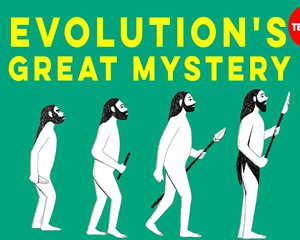In the 1980s, a bonobo named Kanzi learned to communicate with humans to an unprecedented extent
在20世纪80年代,一只名叫坎兹的倭黑猩猩以前所未有的水平学会了与人类交流,
not through speech or gestures, but using a keyboard of abstract symbols representing objects and actions.
并非通过言语或手势,而是通过抽象符号键盘上代表物体和行动的符号字。
By pointing to several of these in order, he created sequences to make requests,
他能通过依序指向键盘符号创造出序列,以提出请求、
answer verbal questions from human researchers, and refer to objects that weren't physically present.
回答人类研究者的口头提问,并指代不在面前的物体。
Kanzi's exploits ignited immediate controversy over one question: had Kanzi learned language?
坎兹惊人的成就立刻引燃了对一个问题的争议:坎兹是否已经学会了语言?
What we call language is something more specific than communication.
我们称作“语言”的东西是一种比交流更为具体的概念。
Language is about sharing what's in our minds: stories, opinions, questions, the past or future, imagined times or places, ideas.
语言是关于分享我们头脑中的东西:故事、观点、问题、过去或未来、想象的时间或地点、理念。
It is fundamentally open-ended, and can be used to say an unlimited number of things.
它本质上是开放性的,能用来表达数量无限的事物。
Many researchers are convinced that only humans have language, that the calls and gestures other species use to communicate are not language.
很多研究者都确信只有人类能使用语言,而其它物种用来沟通的呼叫声和手势并不是语言。
Each of these calls and gestures generally corresponds to a specific message, for a limited total number of messages that aren't combined into more complex ideas.
每种呼叫声和手势通常对应一条特定的信息,信息的总数量有限,并不能组合形成更加复杂的意义。
For example, a monkey species might have a specific warning call that corresponds to a particular predator, like a snake
例如,某种猴子可能有一种特定的警告声对应某种特定的天敌,比如蛇,
but with language, there are countless ways to say "watch out for the snake."
但语言有无数种方式表达“小心有蛇”。
So far no animal communication seems to have the open-endedness of human language.
到目前为止,似乎没有任何的动物交流形式具有和人类语言一样的开放性。
We don't know for sure what's going on in animals' heads, and it's possible this definition of language, or our ways of measuring it, don't apply to them.
我们无法明确地知道动物的头脑中在发生什么,有可能语言的这种定义,或者我们衡量语言的方法对它们并不适用。
But as far as we know, only humans have language.
但据我们目前所知,只有人类具有语言。
And while humans speak around 7,000 distinct languages, any child can learn any language, indicating that the biological machinery underlying language is common to all of us.
另外,人类有着近七千门不同的语言,任何小孩都能学会任何语言,这意味着掌管语言的生物机能是我们所有人共有的。

So what does language mean for humanity? What does it allow us to do, and how did we come to have it?
那么语言对人类意味着什么?它能让我们做什么,我们又如何拥有了语言?
Exactly when we acquired this capacity is still an open question.
我们获得这种能力的确切时间仍是一个有待回答的问题。
Chimps and bonobos are our closest living relatives, but the lineage leading to humans split from the other great apes more than four million years ago.
黑猩猩和倭黑猩猩是我们现存最近的亲戚,但发展成人类的支系早在400万年以前就与其他类人猿分开了。
In between, there were many species -- all of them now extinct, which makes it very difficult to know if they had language or anything like it.
在这期间产生过很多物种--它们现在都已灭绝,也就难以得知它们是否有过语言或者类似语言的系统。
Great apes give one potential clue to the origins of language, though: it may have started as gesture rather than speech.
不过类人猿为语言的起源提供了一个可能的线索:它最初有可能是手势,而非言语。
Great apes gesture to each other in the wild much more freely than they vocalize.
比起发声,野外的类人猿更善于互相打手势。
Language may have begun to take shape during the Pleistocene, 2 to 3 million years ago,
语言有可能是在两三百万年前的更新世开始成型的,
with the emergence of the genus Homo that eventually gave rise to our own species, homo sapiens.
那时出现的人属最后演化成了我们自身所属的物种,智人。
Brain size tripled, and bipedalism freed the hands for communication.
大脑容量扩增到原来的三倍,直立行走解放了双手用于沟通。
There may have been a transition from gestural communication to gestural language -- from pointing to objects and pantomiming actions -- to more efficient, abstract signing.
那时有可能实现了从手势交流到手势语言的转变--从指向物体和模仿动作--变成了更加高效、抽象的手语。
The abstraction of gestural communication would have removed the need for visuals, setting the stage for a transition to spoken language.
手势交流的抽象化消除了对视觉的依赖,从而为向言语的转变备好了舞台。
That transition would have likely come later, though.
然而这个转变有可能在以后才会发生。
Articulate speech depends on a vocal tract of a particular shape.
清晰的言语需要某种特定形状的声道。
Even our closest ancestors, the Neanderthals and Denisovans, had vocal tracts that were not optimal, though they likely had some vocal capacity, and possibly even language.
即使我们最近的祖先,尼安德特人和丹尼索瓦人,他们的声道也都并不完善,虽说他们很可能有一些发音能力,甚至有可能使用语言。
Only in humans is the vocal tract optimal. Spoken words free the hands for activities such as tool use and transport.
只有人类的声带是完善的。口语解放了双手用于其他活动,比如工具使用和运输。
So it may have been the emergence of speech, not of language itself, that led to the dominance of our species.
因此有可能是口语的出现,而非语言本身,促成了人类物种的优势。
Language is so intimately tied to complex thought, perception, and motor functions that it's difficult to untangle its biological origins.
语言和复杂思维、感知及运动功能的联系如此紧密,以至于很难分离出它的生物起源。
Some of the biggest mysteries remain: to what extent did language as a capacity shape humanity, and to what extent did humanity shape language?
有些最大的谜团仍待解答:语言作为能力在何种程度上塑造了人类,人类又在何种程度上塑造了语言?
What came first, the vast number of possible scenarios we can envisage, or our ability to share them?
我们所能想象的众多情景,与我们分享它们的能力--究竟何者在先?












